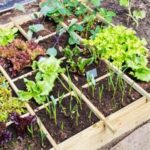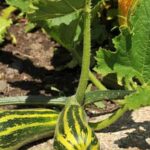Early Ohio vegetable gardens have a rich and diverse history that dates back to the cultivation practices of Native American communities and the influence of European settlers. From adapting to the unique climate and soil conditions of the region to utilizing specific tools and techniques, early Ohioans embraced vegetable gardening as a vital part of their communities.
This article delves into the evolution, challenges, successes, and legacy of these early vegetable gardens, shedding light on their significant impact on modern gardening practices.
The exploration of early Ohio vegetable gardens offers a fascinating insight into the historical development of agricultural practices in the state. By examining the transition from Native American cultivation methods to the introduction of European influences, one can gain a deeper understanding of how vegetables became an integral part of Ohio’s agricultural landscape.
Additionally, considering the climate and soil considerations for early Ohio vegetable gardens provides valuable context for comprehending the challenges faced by early gardeners in producing bountiful harvests.
From commonplace vegetables like corn and squash to lesser-known varieties, early Ohioans cultivated a wide array of produce in their gardens. Understanding the popular vegetables grown in early Ohio sheds light on both the dietary habits and agricultural expertise of these communities. Furthermore, exploring the tools and techniques utilized in early Ohio vegetable gardens provides insight into the ingenuity and resourcefulness of these early gardeners.
The Evolution of Vegetables in Ohio
The rich history of early Ohio vegetable gardens is a testament to the evolution of vegetables in the region, from the cultivation practices of Native Americans to the influence of European settlers. Native American tribes such as the Shawnee, Miami, and Delaware cultivated a variety of vegetables including corn, beans, squash, and pumpkins. These early cultivators used sustainable farming techniques and crop rotation to ensure the fertility of their soil, a practice that continues to be influential in modern gardening.
With the arrival of European settlers in Ohio, new varieties of vegetables were introduced to the region. The Europeans brought with them seeds for cabbage, carrots, onions, and lettuce among others, enriching the variety of vegetables grown in early Ohio vegetable gardens. This fusion of Native American and European cultivation practices contributed to the diverse range of vegetables that were grown in Ohio during this period.
One particularly important aspect that influenced the evolution of vegetables in Ohio was the climate and soil considerations. Early Ohio vegetable gardeners had to work with the fertile but often unpredictable soils and varying climate conditions. They developed techniques for managing these challenges which are still relevant today. The legacy of these early practices can be seen in modern gardening practices across Ohio and beyond.
| Aspect | Detail |
|---|---|
| Early Vegetables | Corn, beans, squash from Native American cultivation; cabbage, carrots from European influence |
| Influence on Modern Gardening Practices | Sustainable farming techniques such as crop rotation; management of varying climate conditions |
Climate and Soil Considerations for Early Ohio Vegetable Gardens
Early Ohio vegetable gardens were highly dependent on the climate and soil conditions of the region. The state experiences a diverse range of weather patterns, including cold winters and warm summers, which had a significant impact on the types of vegetables that could be successfully grown. Additionally, the soil composition varied across different parts of Ohio, influencing the cultivation practices of early gardeners.
When it came to choosing which vegetables to grow in early Ohio, gardeners had to consider the specific climate and soil conditions of their location. Some popular choices included:
- Corn: This staple crop was well-suited to Ohio’s fertile soil and ample sunlight.
- Squash: Varieties such as acorn and butternut squash thrived in the warm summer months.
- Beans: Both pole beans and bush beans were commonly grown due to their adaptability to Ohio’s changing weather.
In terms of soil considerations, Ohio’s rich and fertile soil was favorable for vegetable cultivation. However, gardeners still needed to ensure proper drainage and pH levels for optimal plant growth.
Early Ohio vegetable gardens also faced challenges related to the climate, such as unpredictable frosts and heavy rainfall. Gardeners had to employ various techniques to protect their crops from these environmental factors, including:
- Using row covers or cloches to shield plants from frost damage
- Implementing raised bed gardening to improve drainage during wet periods
- Choosing vegetable varieties that were resilient against sudden temperature fluctuations
Overall, understanding the unique climate and soil considerations of early Ohio was essential for successful vegetable gardening in this historical period. These factors continue to play a crucial role in modern gardening practices in the state.
Popular Vegetables Grown in Early Ohio
Early Ohio vegetable gardens were filled with a variety of vegetables that were well-suited to the climate and soil of the region. The rich agricultural history of Ohio can be seen in the types of vegetables that were popularly grown during this time period.
Some of the popular vegetables grown in early Ohio included:
- Corn
- Beans
- Squash
- Pumpkins
- Potatoes
These vegetables were not only essential for sustenance, but they also played a significant role in the culture and traditions of early Ohio communities. The cultivation and consumption of these vegetables were deeply ingrained in the way of life for early settlers, and they relied on their knowledge of these crops to survive and thrive in their new environment.
In addition to these staple crops, early Ohio vegetable gardens also often featured a variety of herbs such as parsley, chives, and dill, along with other common vegetables like cabbage, onions, and carrots. These vegetables provided essential nutrients and flavors for cooking during a time when access to fresh produce was limited. The popularity and usage of these vegetables in early Ohio gardens have had a lasting impact on modern gardening practices in the region.
Tools and Techniques Used in Early Ohio Vegetable Gardens
Early Ohio Vegetable Gardens were cultivated using a variety of tools and techniques that were influenced by the available resources, technology, and cultural practices of the time.
Hand Tools
Early Ohio settlers primarily used hand tools for gardening, such as spades, hoes, rakes, and trowels. These tools were essential for preparing the soil, planting seeds or seedlings, and maintaining the garden throughout the growing season. The design and materials of these hand tools varied based on what was available in the region at the time.
Irrigation Methods
In the absence of modern irrigation systems, early Ohio vegetable gardens relied on manual watering techniques. Gardeners used watering cans or buckets to water their plants by hand. Additionally, some communities constructed simple irrigation channels to direct water from nearby streams or rivers to their gardens.
Composting and Soil Enrichment
To maintain soil fertility and health, early Ohio vegetable gardeners practiced composting using organic materials such as kitchen scraps, animal manure, and plant debris. They also utilized crop rotation to prevent soil depletion and incorporated natural fertilizers like bone meal or wood ash into the soil.
These traditional tools and techniques used in early Ohio vegetable gardens laid the foundation for modern gardening practices while reflecting the resourcefulness and ingenuity of early settlers in adapting to their environment.
The Role of Vegetable Gardens in Early Ohio Communities
During the early days of Ohio, vegetable gardens played a crucial role in the sustenance and survival of communities. These gardens were not only sources of fresh produce, but they also served as hubs for social interaction and community solidarity. In this section, we will explore the significance of vegetable gardens in early Ohio communities.
Social Interaction and Community Bonding
Vegetable gardens in early Ohio provided a space for community members to come together, work collaboratively, and share knowledge about gardening practices. The act of tending to the garden fostered a sense of camaraderie among neighbors, as they exchanged seeds, tools, and tips for successful cultivation. Additionally, communal workdays in the gardens provided an opportunity for residents to bond over their shared interest in growing food.
Food Security and Self-Sufficiency
In the early days of Ohio, access to fresh produce was not as convenient as it is today. Vegetable gardens served as a means for communities to ensure their own food security and self-sufficiency. By growing their own vegetables, residents were able to supplement their diets with nutritious options and reduce their dependence on outside food sources.
Cultural Traditions and Heritage
The practice of cultivating vegetable gardens was deeply ingrained in the cultural fabric of early Ohio communities. Many families passed down traditional gardening techniques from generation to generation, preserving their agricultural heritage. Additionally, certain vegetables grown in these gardens held cultural significance for different ethnic groups within Ohio, further emphasizing the importance of these vegetable gardens in preserving cultural traditions.
Challenges and Successes of Early Ohio Vegetable Gardens
In the early days of Ohio, vegetable gardening was not without its challenges. The climate and soil in the region presented difficulties for those trying to cultivate a successful garden. The weather in Ohio can be unpredictable, with cold winters and hot summers, making it important for early gardeners to carefully consider the timing of planting and the selection of crops that could withstand these conditions.
Additionally, the soil composition in Ohio varies across the state, with some areas being more fertile than others. Early gardeners had to grapple with these challenges to ensure their vegetable gardens thrived.
Despite these challenges, early Ohio vegetable gardens also achieved great success. Native American cultivation techniques, such as companion planting and crop rotation, were adapted and improved upon by European settlers who brought their own knowledge and experience with gardening.
As a result, early Ohio vegetable gardens were able to produce a variety of vegetables that sustained communities throughout the state. The resilience and ingenuity of these early gardeners is evident in the wide array of vegetables that were successfully grown in spite of the challenges they faced.
The legacy of early Ohio vegetable gardens continues to influence modern gardening practices. Many of the techniques and tools used by early Ohio gardeners are still relevant today, demonstrating their enduring effectiveness. By understanding the challenges faced by early Ohio vegetable gardens and recognizing their successes, we gain valuable insight into how to overcome obstacles in our own gardening endeavors.
| Challenges | Successes |
|---|---|
| Unpredictable weather | Cultivation techniques adapted from Native Americans |
| Varying soil composition | Diverse range of successfully grown vegetables |
The Legacy of Early Ohio Vegetable Gardens
In conclusion, the legacy of early Ohio vegetable gardens has had a profound impact on modern gardening practices. From the cultivation techniques to the choice of vegetables grown, these historical gardens have left an enduring influence on how we approach gardening today. While these early gardens were borne out of necessity and survival, they have contributed to shaping the way we understand and engage in gardening as a source of sustenance, community, and heritage.
The knowledge and experiences gained from early Ohio vegetable gardens have helped form the foundation for modern agricultural and horticultural practices in the state. From understanding the importance of climate and soil considerations to implementing innovative tools and techniques, the expertise developed by early Ohio gardeners continues to inform our approach to cultivating fruits and vegetables in contemporary times.
This historical legacy serves as a valuable resource for both experienced gardeners looking to deepen their understanding of traditional methods and novice gardeners seeking to connect with Ohio’s rich agricultural history.
Moreover, the role of vegetable gardens in early Ohio communities has left a lasting imprint on how we perceive food production, self-sustainability, and communal well-being. The challenges faced by early Ohio gardeners such as climate fluctuations, pests, and limited resources provide insights into resilience, adaptability, and collaboration within communities.
By recognizing the perseverance and successes of these early gardens, we can gain a greater appreciation for the inherent value of local food production and its impact on our physical and social environment. As we continue to harness this wisdom in our modern gardening practices, we honor the enduring legacy of early Ohio vegetable gardens while striving towards sustainable and community-oriented food systems.
Frequently Asked Questions
What Is the Easiest Vegetable to Grow in Ohio?
The easiest vegetable to grow in Ohio is likely lettuce. Lettuce is relatively low-maintenance, grows well in cooler temperatures, and doesn’t require a lot of space. It’s a great choice for beginners.
What Vegetables Can Be Planted the Earliest?
Early-planted vegetables in Ohio can include cold-hardy options like peas, spinach, radishes, and lettuce. These vegetables can withstand cooler temperatures and are among the first to be planted in the spring.
What Vegetables Should a First Time Gardener?
For a first-time gardener in Ohio, it’s best to start with easy-to-grow vegetables like tomatoes, peppers, zucchini, squash, or herbs like basil and mint. These plants are relatively low-maintenance and can thrive in Ohio’s climate with proper care.

If you’re looking to get into vegetable gardening, or are just looking for some tips on how to make your current garden better, then you’ve come to the right place! My name is Ethel and I have been gardening for years. In this blog, I’m going to share with you some of my best tips on how to create a successful vegetable garden.





